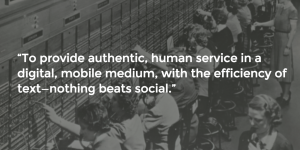Even 30 seconds is too long for today’s in-the-moment, always-engaged customer to wait, spelling trouble for the future of customer service through traditional channels like email and phone. The world is in the middle of the biggest shift in personal computing; the transition from desktop computers to smartphones and tablets requires an entirely new, mobile-first approach to customer service. Furthermore, that approach must be asynchronous, allowing the consumer to engage, disconnect, and pick up where they left off on their own terms.
 There are three major shifts in how people are communicating with each other and with companies, all outside of the traditional call center model.
There are three major shifts in how people are communicating with each other and with companies, all outside of the traditional call center model.
The Social Contact Center
For major companies, social media has risen and now makes up to 10% of all inbound customer contacts, and is growing faster than any other service channel. This powerful tool ensures customer voices are heard, both by companies and customer peers. Social media offers a convenient, mobile-first, real-time medium where customers can demand authentic, human engagement. It’s a hugely powerful tool for companies to engage and connect with their customers in an authentic way. It is potentially more efficient than other digital channels, as long as it is integrated properly into the contact center.
Peer-to-Peer Resolution
Establishing lasting connections is now increasingly essential and difficult, as companies work to build intimacy and loyalty in a time where consumers are more digital, more distant and more discerning. As customers trust brands less, they are beginning to trust their peers more. Customers have found their voice on social, and now that voice is growing louder and more powerful. Customers are turning away from brands and toward each other, expecting faster and more authentic engagement than ever before. Based on primary research, 50% of customers aged 18-29 are more likely to turn to social media when they have a technical issue rather than a support forum. This leads to challenges with delivering large-scale customer service in a channel that’s less structured and more emotional.
Mobile Messaging Applications
Mobile messaging consists of applications that provide over-the-top messaging functionality on phones and tablets (delivered via data, rather than an SMS network). WhatsApp and Facebook Messenger are the biggest in the West; WeChat is huge in Asia; and there are more coming up (Line, Kik etc).
These messaging apps are the biggest new force in communication, and only growing. The daily message volume on WhatsApp (owned by Facebook) is now 50% bigger than global SMS volume. Although standalone apps, these can be related to ‘traditional’ social media platforms; e.g. private messages initiated from a Facebook page all come through Messenger. Even Twitter DMs share a lot of the same characteristics.
What’s Next?
Plugging social media into traditional contact center models doesn’t work. Contact centers can’t treat social like asynchronous emails, or they can miss the real-time nature, leading to missed consumer expectations and loss of trust. With 64% of consumers preferring texting over voice as a customer service channel when given the choice, customer-centric organizations need to have real agents who are empowered to be flexible, authentic and able to resolve real issues in-channel. To provide authentic, human service in a digital, mobile medium, with the efficiency of text—nothing beats social. It’s where customers are being human, and it’s where a brand can respond in kind. Contact centers that get both of these elements right can lower service costs while significantly increasing customer satisfaction.
Its clear therefore that social media is not just growing—it’s growing up, with awareness and ownership spreading to the rest of the organization, especially into the contact center.
With this in mind, I thought this recently published report from Ovum would be of interest.
Read this thought-provoking paper to:
- Discover the Future Contact Center: Identify how social customer support differs from traditional service and how your contact center must adapt.
- Create personalization at scale: Best practices for social customer service to achieve full issue resolution for every customer interaction.
- Gain a competitive advantage: Realize the benefits of shifting from using social media to measure marketing reach to seizing it as an opportunity for best-in-class customer service.
(228)
Report Post







